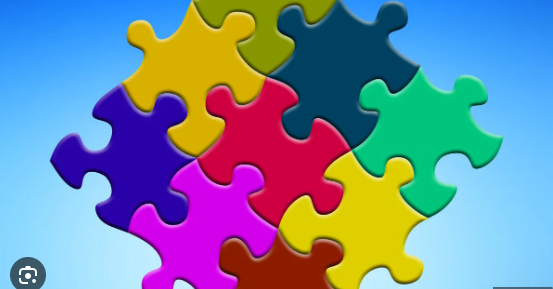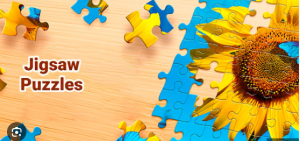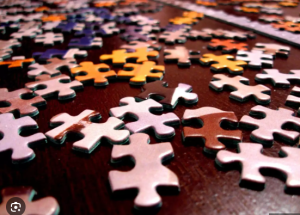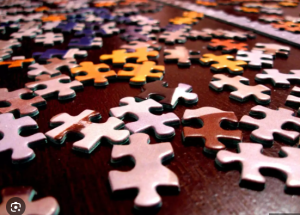I. Introduction
- Hook: A brief anecdote or interesting fact about the allure of puzzles.
- Definition: Define what a puzzle is and its appeal to individuals of all ages.
II. Choosing the Right Puzzle
- Understanding Types: Discuss various puzzle types (jigsaw, crosswords, Sudoku, etc.) and their unique characteristics.
- Personal Preference: Highlight the importance of choosing a puzzle that aligns with one’s interests and skill level.
III. Preparing to Tackle the Puzzle
- Setting the Stage: Create an ideal environment for puzzle-solving (e.g., good lighting, comfortable space).
- Organizing Tools: Gather necessary materials (puzzle pieces, pens, puzzle glue, etc.).
IV. Getting Started
- Sorting Strategy: Sorting pieces by color, shape, or edge pieces to ease the beginning stage.
- Focusing Techniques: Highlight concentration methods and techniques to enhance focus while solving.
V. The Puzzle-Solving Process
- Edge Work: Explain the importance of assembling the puzzle’s edges first.
- Building Blocks: Detail the strategy for assembling the main sections or prominent parts.
- Patience and Persistence: Emphasize the role of patience and perseverance in solving challenging sections.
VI. Overcoming Challenges
- Dealing with Difficulties: Tips for handling tricky areas or sections.
- Taking Breaks: Discuss the benefits of taking breaks to prevent burnout and gain a fresh perspective.
VII. Finishing Touches
- Final Stages: Approaches to solving the remaining portions of the puzzle.
- Celebrating Success: Encourage celebrating the accomplishment, regardless of the puzzle’s size.
VIII. Advanced Puzzle-Solving Techniques (Optional)
- Advanced Strategies: For enthusiasts looking to delve deeper into puzzle-solving techniques.
- Expert Tips: Insights from seasoned puzzle enthusiasts or professionals.
IX. Conclusion
- Reflecting on the Journey: Recap the journey from starting a puzzle to completing it.
- Encouragement: Motivate readers to embrace the joy of puzzle-solving and the lessons learned.
X. Additional Resources and Recommendations (Optional)
- Books, Apps, or Communities: Suggest further resources for those eager to explore puzzles further.
- Product Recommendations: Recommend puzzle brands or tools for an enhanced experience.
Step 1: Choose Your Puzzle
Select a puzzle that interests you. Options range from jigsaw puzzles to crosswords, sudoku, logic puzzles, and more. Consider the level of difficulty and your familiarity with the type of puzzle.
Step 2: Gather Your Materials
Ensure you have all the necessary materials for your chosen puzzle. For jigsaw puzzles, this includes the puzzle itself, a flat surface to work on, good lighting, and maybe a reference image. For other puzzles, such as crosswords or sudoku, grab a pencil or pen and the puzzle grid or sheet.
Step 3: Understand the Rules
Read through the instructions or rules of the puzzle carefully. Each type of puzzle has its own set of rules and objectives. Understanding them beforehand will prevent frustration later on.
Step 4: Start With the Edges (for Jigsaw Puzzles)
If you’re tackling a jigsaw puzzle, start by finding and assembling the edge pieces to form the border. This provides a framework to build upon and makes it easier to fill in the rest of the puzzle.
Step 5: Sort Pieces (for Jigsaw Puzzles)
Separate the remaining pieces by color, pattern, or any distinctive features. Grouping them based on similarities can speed up the process of finding where they fit.
Step 6: Work in Sections
For jigsaw puzzles, focus on smaller sections within the larger picture. Look for distinct patterns, colors, or objects that can be connected. For other puzzles, such as crosswords or sudoku, start with clues or numbers that seem most evident.
Step 7: Trial and Error
Don’t be afraid to try different combinations or solutions. Puzzles often involve trial and error, especially when you’re stuck. Sometimes, taking a break and returning with fresh eyes can help you see the solution more clearly.
Step 8: Patience Is Key
Puzzles require patience. It’s normal to feel frustrated or stuck at times. Take breaks if needed, as it can help reset your mind and prevent fatigue.
Step 9: Check Your Progress
Regularly review your progress. Ensure that the pieces or solutions you’ve placed earlier still fit logically as you move forward. Double-check for any errors.
Step 10: Finish and Enjoy
Once you’ve completed the puzzle, take a moment to appreciate your accomplishment. Admire the finished picture or completed grid. Revel in the satisfaction of solving the puzzle!
Conclusion
Playing puzzles is a fantastic way to challenge your mind, improve problem-solving skills, and relax. Remember, the process is as enjoyable as the end result, so take your time and savor every moment of the puzzle-solving experience.
Introduction
Puzzles are captivating, stimulating challenges that engage the mind and provide a satisfying sense of accomplishment when completed. Whether it’s a jigsaw puzzle, crossword, Sudoku, or any other type, playing puzzles can be a delightful pastime that sharpens cognitive abilities. Here’s a comprehensive guide on how to approach and conquer puzzles of various kinds.
Choosing the Right Puzzle
Begin by selecting a puzzle that aligns with your interests and skill level. For instance, if you’re a visual thinker, a jigsaw puzzle might be ideal. If you enjoy wordplay, crossword puzzles could be a great choice. Consider the complexity, theme, and size of the puzzle as well. Starting with a manageable challenge can build confidence and pave the way for tackling more intricate puzzles later.
Setting the Stage
Create an environment conducive to puzzle-solving. Find a well-lit and comfortable space with ample room to spread out your puzzle pieces or materials. Ensure you have a flat surface to work on to prevent any disruptions or disturbances during the process.
Understanding the Puzzle
Take a moment to familiarize yourself with the puzzle’s objective and rules. Read any accompanying instructions or clues carefully. This step is crucial, especially for puzzles like Sudoku or crosswords that have specific guidelines or patterns to follow.
Organizing and Sorting
For jigsaw puzzles, start by sorting the pieces by color, edges, or patterns. Grouping similar pieces together streamlines the process and makes it easier to identify where they might fit in the larger picture. For other types of puzzles, organize your tools—pens, pencils, erasers, and reference materials—to stay focused and efficient.
Begin with the Borders
For jigsaw puzzles, assembling the border provides a framework to work within. Identify edge pieces and start connecting them to form the puzzle’s outline. This establishes the puzzle’s boundaries and simplifies the process of filling in the interior.
Work Methodically
Approach the puzzle systematically, focusing on smaller sections or areas at a time. For jigsaw puzzles, concentrate on distinct sections based on colors or patterns. With crosswords or Sudoku, start with clues or cells that seem more evident or solvable. Gradually build momentum by solving one part before moving to the next.
Patience and Persistence
Puzzle-solving requires patience and persistence. Embrace the challenge, knowing that some puzzles may take longer to complete than others. Take breaks when needed to refresh your mind and prevent fatigue.
Seeking Help or Clues
If you’re stuck on a particular section, don’t hesitate to seek help. Ask a friend, consult a puzzle-solving guide, or search for hints online. However, try not to rely too heavily on assistance, as the satisfaction of completing a puzzle independently is immensely rewarding.
Completion and Reflection
Once the final piece is in place or the puzzle solved, take a moment to admire your accomplishment. Reflect on the strategies and techniques that worked well for you and consider how you might approach future puzzles differently.
Conclusion
Playing puzzles is not just a leisure activity but also an excellent way to exercise the brain, enhance problem-solving skills, and relax the mind. By following these steps and embracing the challenge, you’ll find joy and fulfillment in conquering puzzles of all kinds.



